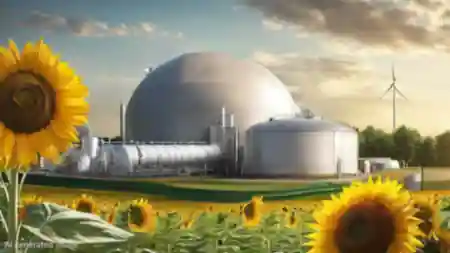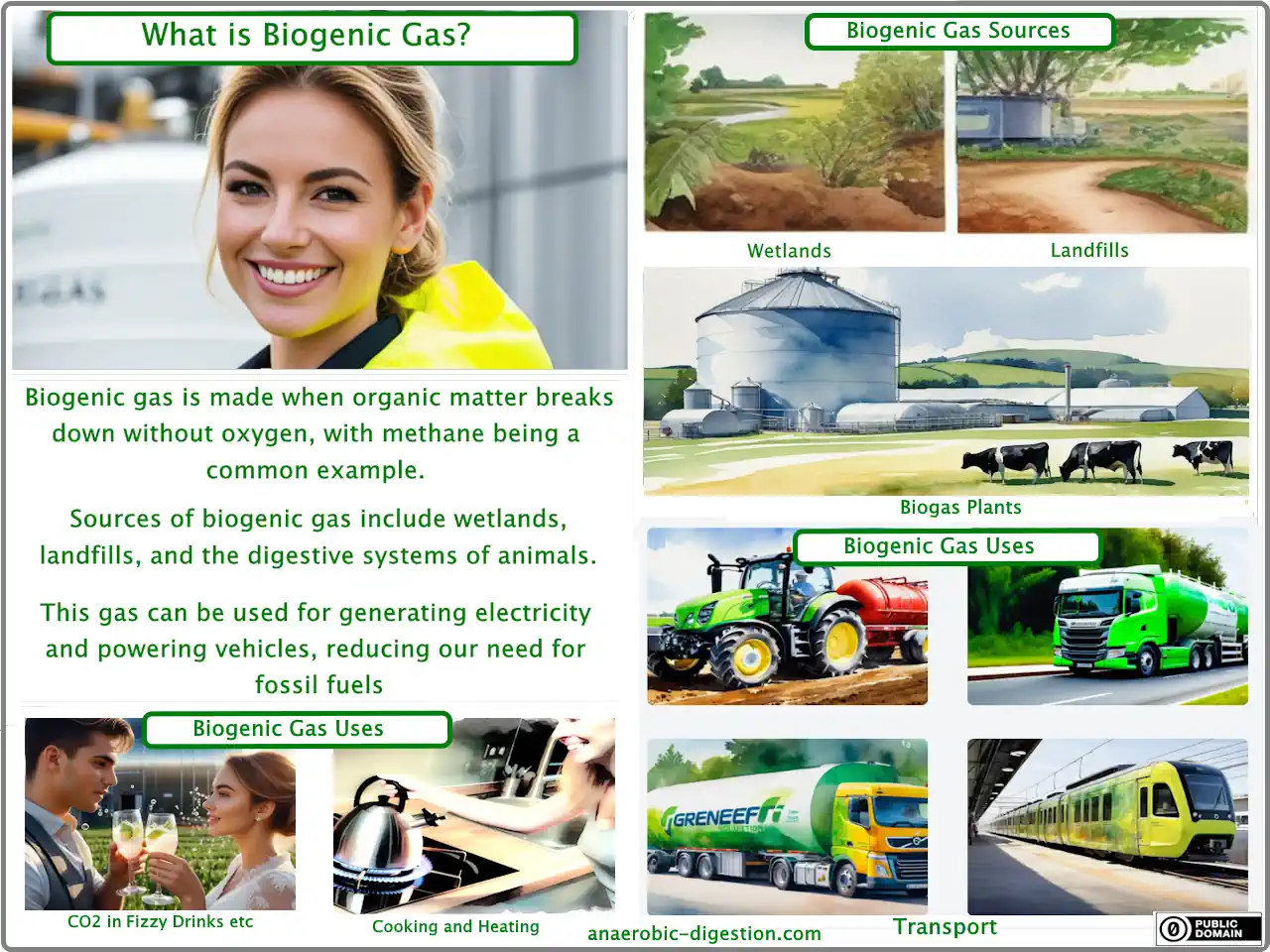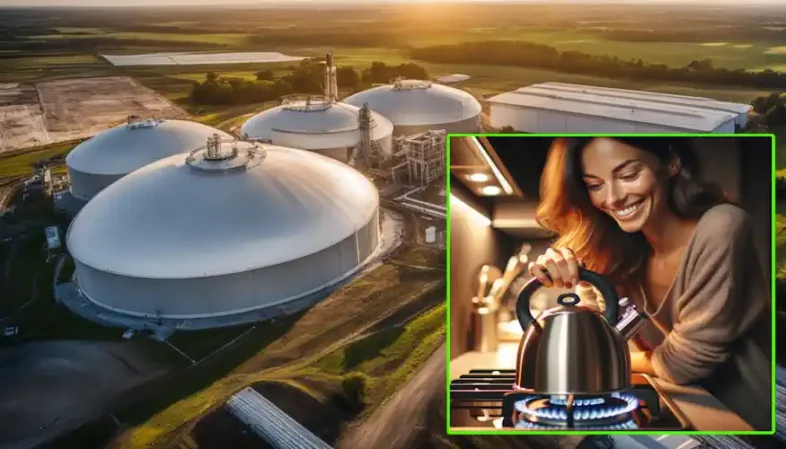Technology is moving on with progress in decarbonisation. When once there was only fossil fuel gas (natural gas) there is now a new category of gas, and its name is “biogenic”! So, we set out to define: What is Biogenic Gas? with biogenic gas examples Including biogenic methane
Finding a clean energy source is on everyone's mind these days. Did you know, biogenic gas, like methane, comes from natural processes? This article will show how biogenic gases are made and how they can solve some of our energy problems.

Let’s get started.
Key Takeaways for What is Biogenic Gas
- Biogenic gas is made when organic matter breaks down without oxygen, with methane being a common example.
- Sources of biogenic gas include wetlands, landfills, and the digestive systems of animals.
- This gas can be used for generating electricity and powering vehicles, reducing our need for fossil fuels.
- Special tests help scientists figure out if gas comes from biological sources. This helps in making smart choices about using natural resources.
- Using biogenic gases like methane and biomethane supports cleaner energy production and helps fight climate change by cutting down greenhouse gases.
What is Biogenic Gas?

Biogenic gas is a naturally occurring type of fuel produced by the degradation of organic matter in the absence of oxygen. The primary source of biogenic gas comes from anaerobic bacteria breaking down organic materials such as plants, animal waste, and landfill waste.
Until recently biogenic gas was little more than an interesting phenomenon of useless gas given off by wetland bogs. But in the last 20 years, science has begun to realize how this truly “natural” gas can have a huge role in fighting climate change.
Definition and sources
Biogenic gas comes from organic materials breaking down. This happens in areas where there's little to no oxygen, like deep underwater or under the earth. Tiny organisms have worked on plants and animal remains for thousands of years to create this gas.
Places rich in organic matter become hotspots for biogenic gas formation.
Sources are varied, ranging from vast wetlands to the guts of cows and even landfills packed with waste. Each source contributes differently to the overall production of biogenic gas, making it a diverse field for research and application in sustainable practices.
Through biogenic testing for hydrocarbon, scientists identify and quantify these gases’ presence, paving the way for innovative energy solutions.
If these gases escape into the air, they might possibly also add to climate-changing greenhouse gases in the atmosphere, but in the case of biogenic gases, this only matters if they are not part of the natural carbon cycle.
Natural processes of production
Moving from the basics of what biogenic gas is and where it comes from, let's explore how nature creates this valuable resource. Plants, animals, and other organic matter are key players in this process.
They break down and decay over time, especially in environments with little to no oxygen. This breakdown happens thanks to bacteria that thrive in such conditions. These microbes convert the organic materials into biogenic gases like methane.
Lakes, wetlands, and even landfill sites become hotspots for producing these gases naturally. The absence of oxygen is crucial because it sets the right stage for anaerobic digestion—a process where bacteria digest biomass without air.
This digestion not only produces what is biogenic gas but also helps reduce waste volumes by breaking down its organic components. In essence, nature has a way of recycling biological waste into something useful: energy-rich gases that can power our homes and industries.
Biogenic Gas Examples

Biogenic gas examples include methane, biomethane, and biogenic carbon dioxide. These gases are produced through natural processes and have various applications in energy production and environmental management.
Methane as a biogenic gas
Methane stands out as a key example of biogenic gas, mainly coming from sources like wetlands, landfills, and the digestive systems of animals. This type of methane forms through natural processes where microorganisms break down organic matter in environments with little to no oxygen.
If you still need help with understanding what is biogenic gas, think about cows' stomachs or decomposing plant material in a swamp; both are prime examples of where this gas comes from.
The process involves several steps before methane can be used for things like generating electricity or powering vehicles. Waste management professionals and environmental researchers focus on capturing this gas efficiently to turn it into usable energy.
They use tools like digesters and capture systems designed specifically for these purposes. Capturing methane not only provides a renewable source of energy but also helps in reducing the impact of climate change by preventing this potent greenhouse gas from entering the atmosphere unchecked.

Other examples of biogenic gases including biomethane and biogenic CO2
Biogenic gas doesn't end with methane. This group of gases, coming from organic matter decomposition and natural biological processes, includes others like biomethane and biogenic CO2. Each plays a crucial role in our ecosystem and offers potential for sustainable energy.
- Biomethane – It mirrors natural gas but is renewable. Produced through the anaerobic digestion of organic waste, biomethane can come from landfills, wastewater treatment plants, and agricultural waste. Once cleaned and purified, it serves as a green substitute for conventional natural gas in heating homes, generating electricity, or fueling vehicles.
- Biogenic CO2 – While carbon dioxide often gets bad press for its role in climate change, biogenic CO2 is different. This version results from the combustion of biomass materials like wood, crops, and waste from animals or humans. It's part of a closed carbon cycle where plants absorb the same amount of CO2 during growth as they release when burnt or decomposed. Hence, using biogenic CO2 can help reduce greenhouse gas emissions by replacing fossil fuels.
These examples show the diversity and potential of biogenic gases beyond methane through CO2 carbon capture etc. They underscore the possibilities for advancing green energy solutions and mitigating environmental impact through innovative technologies and approaches to waste management.
Uses and Benefits of What Biogenic Gas Is
What is biogenic gas, such as methane and biomethane, serves as a sustainable energy source. These gases contribute to environmental conservation and aid in waste management, promoting a cleaner ecosystem.
Energy production

Biogenic gases like methane can light up our world in ways we hadn't imagined. I've seen this first-hand while visiting a biogas plant. They take waste materials and turn them into power.
This process not only gets rid of waste but also creates renewable energy. It shows how nature's leftovers can brighten homes and fuel industries.
Plants across the globe are now using these gases to produce electricity and heat. This method is clean, and efficient, and reduces reliance on fossil fuels. By converting organic waste into what is biogas, we tackle two major issues: managing waste and finding sustainable energy solutions.
Environmental applications
Biogenic gas offers a green solution to tackle climate change. It can turn waste into wealth, reducing greenhouse gases by capturing methane from organic matter decay. This method supports renewable energy sources and cuts down our reliance on fossil fuels.
When people do understand what Is biogenic gas, they appreciate that, with the right technology, we can harness this power safely and efficiently for heating homes, generating electricity, and fueling vehicles.
This approach not only fights global warming but also promotes sustainable agriculture practices by using biodegradable materials as feedstock for biogas production. Farmers benefit from a dual-income stream—selling crops and the biogenic gases produced from crop waste.
By integrating these systems into current waste management strategies, government bodies create cleaner cities and contribute towards a circular economy where nothing goes to waste.
Biogenic Testing for Hydrocarbon
Scientists use special tests to find out if gas comes from living things or not. These tests help us understand where the gas under the Earth's surface comes from. This is important for environmental researchers, waste management professionals, and government officials.
They need this information to make smart decisions about using our natural resources.
One method involves analysing the gas' makeup. They look at elements like carbon isotopes in methane to tell if it's biogenic—or made by life processes. Tools like mass spectrometers play a big part in this work.
They give scientists detailed info about the gas, helping them figure out its origins quickly and accurately. This knowledge helps us use resources better and protect our environment.
What Is Biogenic Gas? Conclusion

In conclusion, biogenic gas, such as methane and biomethane, is produced through natural processes. Its uses in energy production and environmental applications make it vital for sustainable practices.
Implementing biogenic testing for hydrocarbons enhances waste management and ensures the quality of energy sources. Emphasising practicality and efficiency highlights how easily implementable strategies can lead to significant improvements.
The potential impact of these approaches on our environment underscores the importance of embracing biogenic gas utilisation.
What Is Biogenic Gas? FAQs
1. What is biogenic gas?
Biogenic gas is a natural gas formed by the breakdown of organic matter, like plants and animals, without oxygen.
2. Can you give an example of biogenic gas?
Yes, methane is a common example of biogenic gas that comes from swamps and landfills.
3. How does biogenic gas form?
It forms when microorganisms break down organic material in environments with little to no air.
4. Is biogenic gas important for anything?
Absolutely, it's used for heating homes and generating electricity – quite handy!
5. Where can we find biogenic gases naturally?
You'll find biogenic gas in wetlands, marshes, and even inside cows' stomachs!




